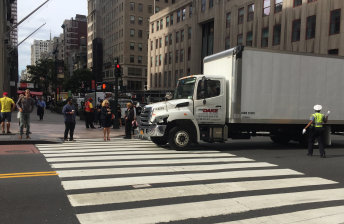Is the NYPD Reducing Traffic Violations? Hard to Say…

Continuing Streetsblog’s breakdown of the Mayor’s Management Report [PDF], we turn our attention this week from DOT to the NYPD section (page 119).
The MMR, if you’ll recall, is released every year as "a public report card on City services affecting the lives of New Yorkers." In addition to tracking felonies and violent crime, the NYPD section measures traffic violations — or, to be precise, how many tickets police hand out. As a performance metric, this leaves something to be desired, because it does not gauge the extent to which drivers actually break traffic laws.
"Cops really need to change the way they measure performance in terms of traffic infractions," says Paul Steely White of Transportation Alternatives. "They track the number of summonses, but what they don’t measure is the level of compliance."
By only counting tickets, NYPD cannot tell whether traffic violations are increasing or decreasing year-to-year, as the department does with felonies. Tracking reports of, say, grand larceny reflects the incidence of that type of crime fairly well, but tallying the number of speeding tickets issued reveals only a fraction of all speeding.
Counting summonses also gives the false impression that hazardous
traffic violations cannot be systematically addressed the same way the
department has drastically reduced violent crime.
"They could triple the number of summonses but that would have little impact on compliance," says White.
If the NYPD were to compile thorough data on compliance, a better case
could be made for greatly expanding automated enforcement measures such as red
light cameras. A 2001 study released by
the city comptroller’s office estimated that drivers burn red lights
1.23 million times every day in New York City. By comparison, the NYPD issued 874,929 summonses for hazardous moving violations in all of fiscal year 2007, according to this year’s MMR.

A table from this year’s MMR showing traffic deaths and enforcement data.
The NYPD took a step toward better measurement in 1998, when it launched TrafficStat, a system based on its highly successful CompStat accountability process. But TrafficStat focuses on hotspots where crashes tend to occur. It doesn’t capture systemwide data on violations.
"Once [compliance data] is ascertained, that’s only going to enforce the rationale for red light cameras," says White. He predicts that getting a better handle on the scale and scope of traffic violations will put pressure on Albany to act, since the NYPD won’t be able to crack down using manpower alone. "To get the political will to undertake an automated enforcement program, you need that data to show that this is citywide, every day."
NYPD has not yet responded to requests for comment and more information about how it gathers data on traffic violations.
Photo: Photo Gallery / Flickr
